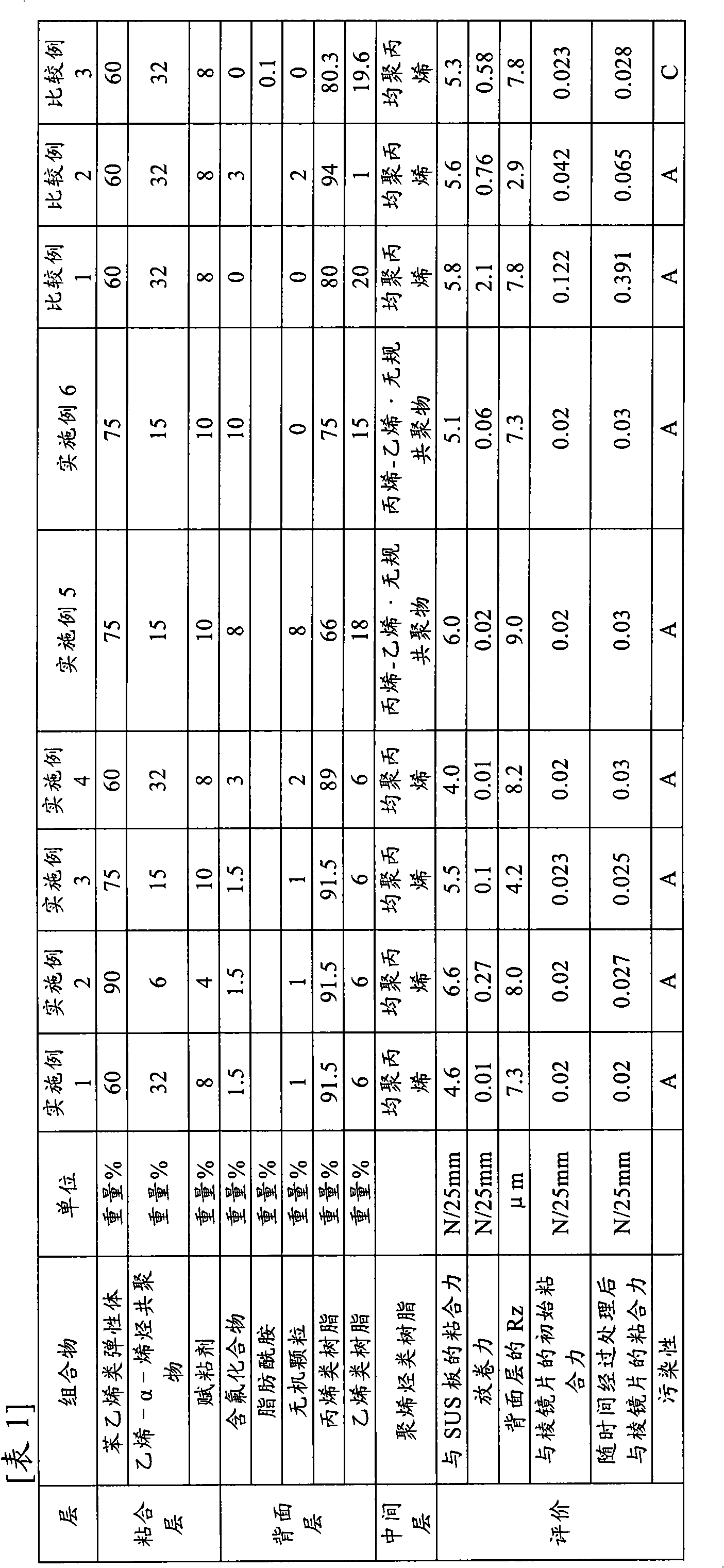Surface protection film
A technology of surface protection film and back layer, applied in the direction of film/sheet adhesive, adhesive type, coating, etc., can solve problems such as difficulty in peeling off, reduced adhesion, easy peeling, etc., to achieve Good reproducibility and excellent sliding properties
- Summary
- Abstract
- Description
- Claims
- Application Information
AI Technical Summary
Problems solved by technology
Method used
Image
Examples
Embodiment 1
[0094] The constituent resins of the respective layers were prepared as follows.
[0095] Adhesive layer resin: A resin composition consisting of a styrene-based elastomer containing 10% by weight of styrene and having an MFR of 10 g / 10 minutes at 230° C. was uniformly mixed with a Henschel mixer. · Butadiene · random copolymer 60% by weight; as an ethylene-α-olefin copolymer, the density is 0.921kg / m 3 And 20% by weight of hexene copolymerized polyethylene (linear low-density polyethylene) with MFR of 5g / 10 minutes at 190°C; and 20% by weight of masterbatch with 40% by weight of hydrogenated terpene phenol as a tackifier .
[0096] Here, as the masterbatch containing 40% by weight of the hydrogenated terpene phenol, a masterbatch of 40% by weight of the hydrogenated terpene phenol and 60% by weight of the above-mentioned hexene-copolymerized polyethylene was used in advance with a twin-screw extruder.
[0097] Back layer resin: 45% by weight of homopolypropylene with an MFR...
Embodiment 2、3
[0111] As the adhesive layer resin of Example 2, a material obtained by mixing styrene, butadiene, and styrene with an MFR of 10 g / 10 minutes at 230°C containing 10% by weight of styrene using a Henschel mixer was used. A product obtained by uniformly mixing 90% by weight of a regular copolymer with a resin composition of 10% by weight of a masterbatch-formed product having a density of 0.91 kg / m 3 60% by weight of hexene-copolymerized polyethylene (linear low-density polyethylene) with an MFR of 15 g / 10 minutes at 190° C., and 40% by weight of hydrogenated terpene phenol as a tackifier were previously used in a twin-screw extruder obtained by masterbatching.
[0112] In addition, as the adhesive layer resin of Example 3, a material obtained by uniformly mixing a resin composition composed of a resin composition containing 10% by weight of a styrene component and having an MFR of 10 g / 10 at 230° C. with a Henschel mixer was used. Min styrene·butadiene·random copolymer 75% by ...
Embodiment 4
[0115] As the adhesive layer resin and the intermediate layer resin, a resin having the same resin composition as in Example 1 was used. As the back layer resin, 20% by weight of homopolypropylene with an MFR of 5 g / 10 minutes at 230°C and 24% by weight of a propylene-ethylene random copolymer with an MFR of 30 g / 10 minutes at 230°C (with an ethylene content of 5% by weight) ), the MFR at 190°C is 2g / 10 minutes and the density is 0.92g / cm 3 6% by weight of low-density polyethylene and 50% by weight of the following mixed composition prepared in advance as a masterbatch are uniformly mixed using a Henschel mixer. The mixed composition is composed of the above-mentioned homopolypropylene 90% by weight, average The composition consisted of 4% by weight of silica with a particle diameter of 11 μm, and 6% by weight of a fluorine-containing compound having a polyfluorocarbon group and a polyoxyethylene group. Except for this, it carried out similarly to Example 1, and produced the ...
PUM
| Property | Measurement | Unit |
|---|---|---|
| particle diameter | aaaaa | aaaaa |
| softening point | aaaaa | aaaaa |
| particle size | aaaaa | aaaaa |
Abstract
Description
Claims
Application Information
 Login to View More
Login to View More - R&D
- Intellectual Property
- Life Sciences
- Materials
- Tech Scout
- Unparalleled Data Quality
- Higher Quality Content
- 60% Fewer Hallucinations
Browse by: Latest US Patents, China's latest patents, Technical Efficacy Thesaurus, Application Domain, Technology Topic, Popular Technical Reports.
© 2025 PatSnap. All rights reserved.Legal|Privacy policy|Modern Slavery Act Transparency Statement|Sitemap|About US| Contact US: help@patsnap.com

